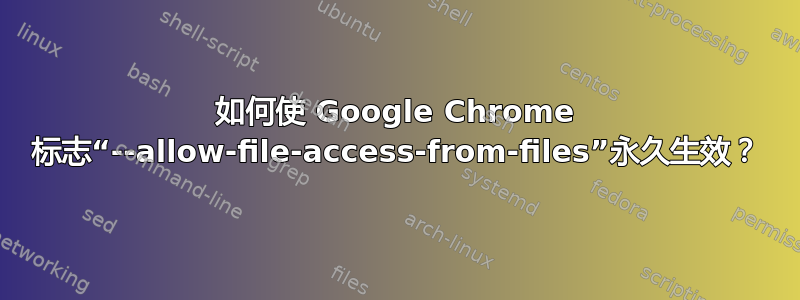
如果你想允许本地文件访问谷歌浏览器中的本地文件,你可以进入终端并运行
$ google-chrome --allow-file-access-from-files
答案1
导航到桌面启动器/菜单项,打开 Google Chrome 的启动器属性对话框。
它看起来应该是这样的:
/usr/bin/google-chrome %U
要使所需的标志永久生效,请将其修改为类似以下内容:
/usr/bin/google-chrome --allow-file-access-from-files
修改后,您可能还需要删除并重新固定图标启动器。修改后,Chrome 应在启用指定标志的情况下启动。
或者,您可以简单地使用上述内容创建一个新的启动器并使用它来启动 chrome。
要检查您修改的标志是否正在加载:
$ cat ~/.config/google-chrome/Local\ State
并向上滚动到标题为
"session_restore"
你的标志应该在块中列出,在之前
--flag-switches-begin --flag-switches-end。
打开 Chrome 并导航到 URL
chrome://version/
还应列出启用的标志
Command Line
堵塞
这是 google-chrome / chromium 标志的列表:
答案2
答案3
Google-chrome 和 Chromium 的功能应该相同,除了多媒体(特别是 Flash)和一些文件/文件夹位置(chromium 而不是 google-chrome)之外,差异很小,请参阅http://code.google.com/p/chromium/wiki/ChromiumBrowserVsGoogleChrome
你应该看看https://wiki.archlinux.org/index.php/Chromium_Tips_and_Tweaks 尤其:
Making it all persistent
You can export your flags from ~/.profile:
export CHROMIUM_USER_FLAGS="--disk-cache-dir=/tmp --disk-cache-size=50000000"
Or add them to /etc/chromium/default:
# Default settings for chromium. This file is sourced by /usr/bin/chromium
#
# Options to pass to chromium
CHROMIUM_FLAGS="--scroll-pixels=200"
Chromium will prefer the user defined flags in CHROMIUM_USER_FLAGS to those defined in
/etc/chromium/default.


